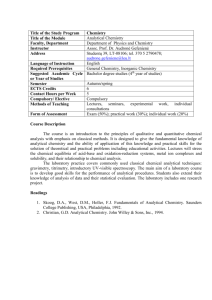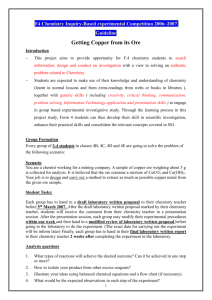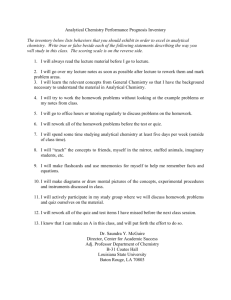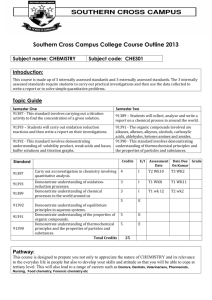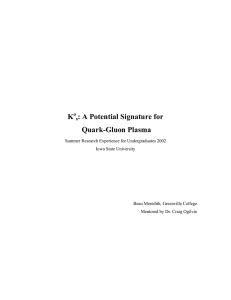CHL 141 Analytical Chemistry Laboratory
advertisement
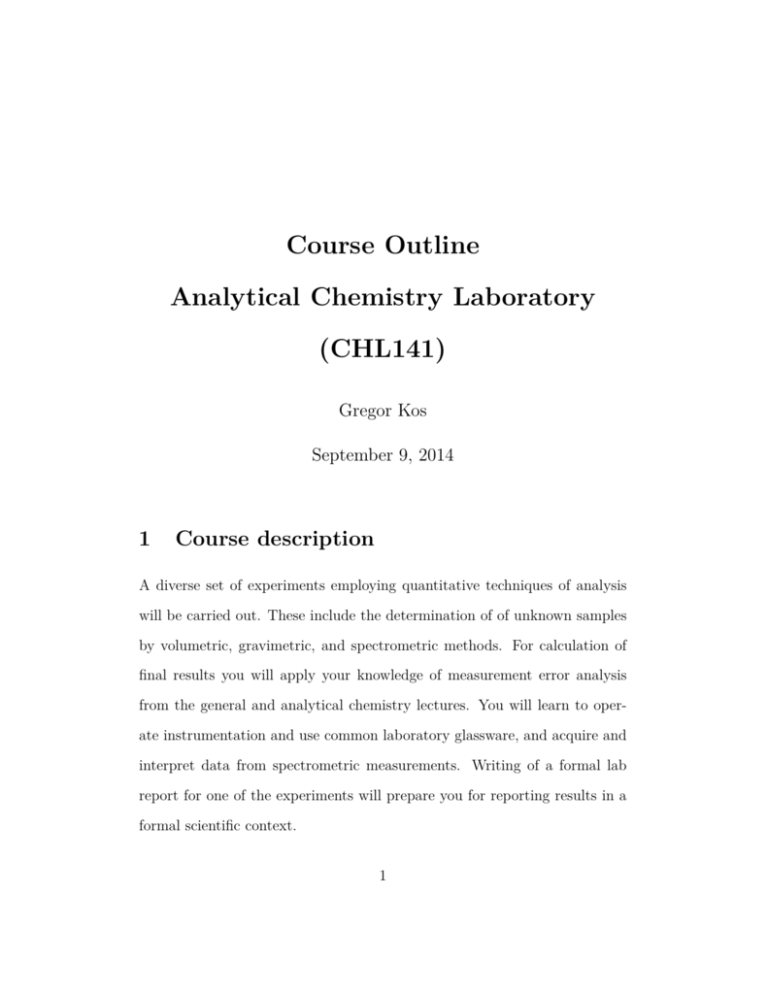
Course Outline Analytical Chemistry Laboratory (CHL141) Gregor Kos September 9, 2014 1 Course description A diverse set of experiments employing quantitative techniques of analysis will be carried out. These include the determination of of unknown samples by volumetric, gravimetric, and spectrometric methods. For calculation of final results you will apply your knowledge of measurement error analysis from the general and analytical chemistry lectures. You will learn to operate instrumentation and use common laboratory glassware, and acquire and interpret data from spectrometric measurements. Writing of a formal lab report for one of the experiments will prepare you for reporting results in a formal scientific context. 1 2 Course administration Instructor: Gregor Kos (gkos@ubishops.ca) with Karl Gagnon Office hours: Wed: Open door/by appointment from 11h30 am, J-219 Prerequisites: CHM/L 191 & CHM/L 192 or Collegial Chemistry NYA & NYB Co-requisite: CHM 141 Class time: Thu 1:30–5:30 pm Room: J-210 Course text: G. H. Hickie (edited by G. Kos), CHL141 – Analytical Chemistry Laboratory Manual, Fall 2014. (available in the University Book Store 3 Assessment • Precision of the analytical results (60%); see marking scheme below. Your hard cover lab book with the calculated results must be handed in until Friday, 4 pm following the second session of an experiment. • Written formal lab report for the copper ore or the soluble sulfate experiment (15%). Deadline for submission of the report is the 19 Nov 2014 at 4 pm. Please submit your report as hard copy. • Quality of data, notes & observations recorded in the lab book (10%). For a list of assessment criteria, please see the course website. • Cleanliness of the lab benches and fume hoods (10%). This includes 2 assigned cleaning duty at the end of each lab session. See the schedule is provided on the course website. • Pre-lab quizzes on experimental theory, procedure and safety (5%). • Late submissions – For late submission of experimental results 2 marks out of ten will be deducted; see marking scheme below. – For late submission of the formal report, the report mark will be reduced by 20%. – For any extension without losing marks, please see me in person before the deadline 3.1 Marking scheme for experiments Precision of results - analyses within 0.5% of the correct result: 10 /10 1.0% 9 / 10 1.5% 8 / 10 2.0% 7 / 10 3.0% 6 / 10 4.0% 5 / 10 > 4% 0-4 / 10 Attendance to labs is mandatory. See your instructor before or shortly after – with a doctor?s note – any missed laboratory session. Students must 3 complete all labs or a course grade of 0% will be given. There will be no supplemental examination or make-up work for students who fail this course. 4 Laboratory safety The introductory safety session is mandatory. Safety equipment (safety glasses and lab coat) are mandatory at all times. Long pants give the best protection for your legs, and closed shoes with socks provide good protection for your feet. Open toed shoes are not permitted. Make sure you are familiar with all safety related information for all chemicals used during an experiment. Consult the relevant MSDS sheets before coming to the lab. If you do not wear clothing appropriate to ensure your safety, you will not be admitted to the lab. 5 Lab manual G. H. Hickie (edited by G. Kos), CHL141 – Analytical Chemistry Laboratory Manual, Fall 2014. Available in the University Bookstore. You must be familiar with the introduction and the experiment description before the start of the lab. • Introduction – What is Analytical Chemistry? – The Language of Analysis 4 – The Analysis Process – Application of Statistical Methods in Analysis – Volumetric Analysis – Gravimetric Analysis – Instrumental Optical Methods • Experiments – Analysis of Soda Ash (Acid-base Titration) – Analysis of Iron Ore (Red-ox titration) – Copper Ore Analysis (Titration & Interferent Removal) – Analysis of Soluble Sulphate (Gravimetry) – Analysis of Manganese in Steel (UV-VIS Spectroscopy) – Analysis of an Impure Oxalate (Complex Titration) 6 Opening discussions & pre-lab quizzes Each lab will start with a pre-lab quiz for the experiment and a 10 min discussion of the background, relevant measurement principles and techniques. You must prepare for each lab in advance and be familiar with all safety-related aspects of the experiment to be performed. Consult the MSDS sheets for all chemicals employed during an experiment. 5 7 Schedule of experiments 03 Sep Introduction and safety in the lab 10 & 17 Sep Soda ash 24 Sep & 01 Oct Iron ore 08 & 15 Oct Copper ore Lab book peer review (15 Oct) 22 & 29 Oct Soluble sulfate 05 & 12 Nov Manganese in steel 19 Nov Soluble oxalate Deadline for submission of formal lab report 26 Nov Makeup lab Deadline for submission of lab book 8 Hints for writing a formal lab report You will be handing in a lab report for one experiment performed (choose the Copper Ore or the Soluble Sulfate lab). Use the lab report checklist provided on the Moodle site of the course to check for completeness of the formal requirements. Report length is not a criterion for assessment, although a typical report will be about 4–6 pages long without the raw data appendix). Here are a few more hints on how to write a good report: Prepare separate sections for introduction, experimental set-up, results and discussion of the experiment. If you have questions to answer, integrate 6 the answers into your report. An appendix with the raw data is attached to your report (you may copy/scan the relevant pages in your lab book). 1. The “Introduction” provides context to the experiment and answers questions such as the following: What is the motivation for the presented experiment? What comparable research has been done before? What is the objective of the experiment? Use peer-reviewed articles or scientific text books as references throughout. 2. The “Experimental” section provides a brief description of the methods and equipment used; do not copy/paste from the lab manual, but describe, what you have done in past tense based on your lab book notes. 3. The “Results” section provides a concise summary of the data acquired, usually in tabular format, with a summary of observations during data acquisition. Any observations during the experiment that will be helpful interpreting the data are included in this section. 4. The “Discussion” section analyses and interprets the data. It provides context with comparable work, which is listed as references. An error analysis is usually included. Do not forget to reference your data throughout your discussion. Use figures and tables to visualize and support your interpretation of the data. 5. The “Reference” section lists all literature employed for writing the 7 report. Only peer reviewed references (i.e., journal articles and scientific text books) are permitted. Do not use web links as references. An “Appendix” with all your raw data completes the report, including typed-up or original hand-written notes. Whenever you choose to eliminate any acquired data, e.g., because of a systematic measurement error, these data must still be included in the appendix and its removal be discussed in the report. 9 Academic integrity Plagiarism is a kind of academic dishonesty in which an individual uses the work of another without appropriate acknowledgement. Plagiarism includes but is not limited to the following practices: • Using another person’s work without proper acknowledgement • Copying material without quotation marks and a reference • Paraphrasing too closely the exact words of the originating author • Submitting as one’s own work written in whole or in part by another individual The following practices related to plagiarism are also prohibited: • Helping another student plagiarize 8 • Submitting in whole or in part work for which the student has received credit in another course, unless the permission of the instructor has been obtained • Submitting any statement of fact known to be false or providing a fabricated reference to a source 9


